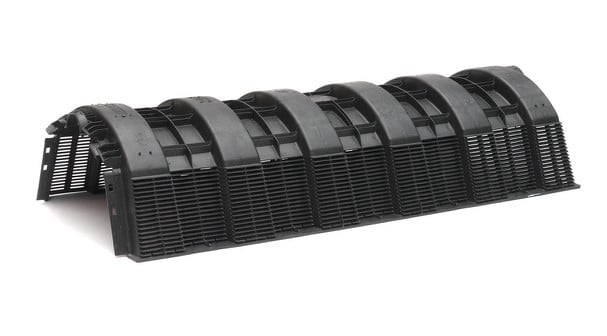H-20 Chamber
The High Capacity Infiltrator Chamber H-20 offers maximum internal volume per linear foot for extra temporary storage capacity. The 10” louvered sidewalls facilitate infiltration and evapotranspiration, while reducing fines in the system. The High Capacity H-20 chamber gets an H-20 load rating with 18” of compacted cover when installed per installation requirements.
Find a Distributor › Contact an Expert › Manuals, Guides & CAD Details ›Specifications:
Size
34"W x 75"L x 16"H
(864 mm x 1905 mm x 406 mm)
Weight
38 lbs
Storage Capacity
110 gal (14.3 cu ft)
Louvered Sidewall Height
10" (254 mm)
Benefits:
- More temporary storage capacity
- Maximum internal volume per linear foot
- Easy assembly and installation with as few as two people, a backhoe and a pickup truck
- Inspection port option for easy access to leachfield with no site disruption
- Overall reduced cost
FAQs:
Many installation requirements and options are governed by local codes instituted by the health department in your area. When in question, check with the local health department for specifics and follow their code instructions. Any design or installation questions not answered here can be directed to the Infiltrator Water Technologies’ Technical Services staff by calling 1-800-718-2754.
Infiltrator chambers can be used in almost any septic leachfield application. Wherever stone and pipe can be installed, Infiltrator chambers can be used. This includes trench, bed, and elevated mound installations. Infiltrator chambers provide superior treatment capabilities in pressure dosing, level distribution, serial distribution, evapotranspiration, and sand filter applications.
System sizing is determined by each local health department. Typically, health departments have approved sizing reductions of 25 to 50 percent when Infiltrator chambers are specified. Check your local health codes for the specifics in your area.
Some health codes do not allow septic leachfields to be installed under impervious surfaces such as driveways. This is because the surface pressure can compact the soil, resulting in a negative effect on the soil’s ability to treat effluent (wastewater). Check with your local health department for the specific codes for your area. If this type of installation is allowed, call Infiltrator Water Technologies’ Technical Services staff at 1-800-718-2754 for design and installation instructions.
Infiltrator Water Technologies recommends a minimum of 12 inches of compacted cover over the chambers. Maximum allowable cover over the chambers in a trench system is 96 inches. In bed systems, the maximum cover is 48 inches. If the drainfield is located in a non-traffic area, minimum cover can be reduced to six inches. Exercise caution with equipment when installing a system at the 6-inch depth. Infiltrator Water Technologies does offer a line of Shallow Cover (SC) Chambers that allow for six inches of cover with an H-10 equivalent loading rate, however these are only available in specific markets. Always check with your local health codes for specific cover requirements.
Yes. To accommodate existing obstacles in system installation, the Quick4 Chambers allow for 10 to 15 degree turns, right or left.
Yes, on the top of each chamber there is a knock-out area that is typically used for an inspection port. When inletting into the inspection port, a splash plate is needed under the inlet. Use caution when backfilling so as not to dislodge the inlet pipe.
Infiltrator chambers have a patented MicroLeaching™ louver design that corresponds to the angle of the soil. This permits effluent to leach out of the sidewall while preventing soil from entering the chamber.
Infiltrator MicroLeaching™ sidewall louvers are designed to keep soil out; therefore filter fabric is not needed. Contact Infiltrator Water Technologies Technical Services for additional information at 1-800-718-2754.
When installing the chambers in sandy soils, mound, or fill systems the sand base should be compacted. This gives the chambers a solid footing and does not adversely affect the infiltration rate of the sands.

